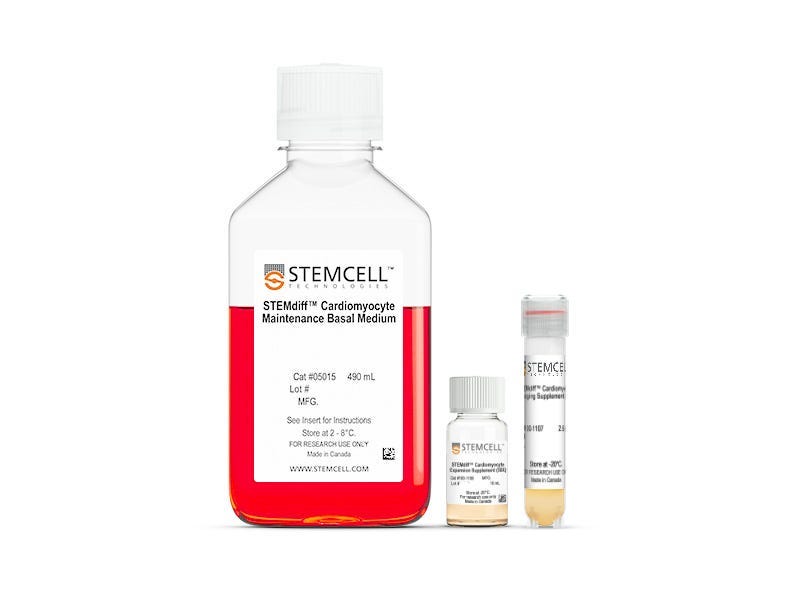STEMdiff™ Cardiomyocyte Expansion Kit
Serum-free kit for the expansion of early-stage human PSC-derived cardiomyocytes
Request Pricing
Thank you for your interest in this product. Please provide us with your contact information and your local representative will contact you with a customized quote. Where appropriate, they can also assist you with a(n):
Estimated delivery time for your area
Product sample or exclusive offer
In-lab demonstration
-
 STEMdiff™ Cardiomyocyte Dissociation Kit
STEMdiff™ Cardiomyocyte Dissociation KitFor dissociation of hPSC-derived cardiomyocytes
-
 STEMdiff™ Cardiomyocyte Support Medium
STEMdiff™ Cardiomyocyte Support MediumMedium for thawing and culturing hPSC-derived cardiomyocytes
-
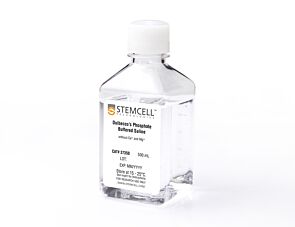 D-PBS (Without Ca++ and Mg++)
D-PBS (Without Ca++ and Mg++)Dulbecco’s phosphate-buffered saline without calcium and magnesium
-
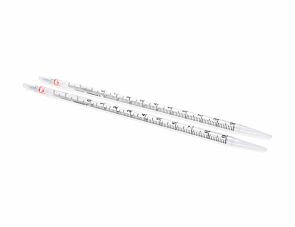 Falcon® Serological Pipettes, 10 mL
Falcon® Serological Pipettes, 10 mLSterile polystyrene pipettes for cell culture
-
Labeling Antibodies
Compatible antibodies for purity assessment of isolated cells
Overview
By using this first-to-market kit to efficiently expand cardiomyocytes, you can save time and resources.
Create a complete, optimized workflow with these compatible STEMdiff™ cardiomyocyte products:
STEMdiff™ Ventricular Cardiomyocyte Differentiation Kit
STEMdiff™ Atrial Cardiomyocyte Differentiation Kit
STEMdiff™ Cardiomyocyte Dissociation Kit
STEMdiff™ Cardiomyocyte Support Medium
STEMdiff™ Cardiomyocyte Freezing Medium
STEMdiff™ Cardiomyocyte Maintenance Kit
Data Figures

Figure 1. Workflow for the Expansion of Early-Stage hPSC-Derived Cardiomyocytes Using the STEMdiff™ Cardiomyocyte Expansion Kit
Expansion of early-stage human pluripotent stem cell (hPSC)-derived cardiomyocytes begins with the differentiation of hPSCs to cardiomyocytes using the STEMdiff™ Ventricular Cardiomyocyte Differentiation Kit or the STEMdiff™ Atrial Cardiomyocyte Differentiation Kit. On Day 11 of differentiation, a beating, confluent monolayer of early-stage cardiomyocytes can be observed. These cardiomyocytes are harvested and replated at low density to initiate expansion using STEMdiff™ Cardiomyocyte Expansion Kit. Expanding hPSC-derived cardiomyocytes can be passaged up to 5 times before switching to STEMdiff™ Cardiomyocyte Maintenance Medium for downstream assays.

Figure 2. Expanding hPSC-Derived Cardiomyocytes Are Confluent One Week After Replating with STEMdiff™ Cardiomyocyte Expansion Kit
Representative images of expanding hPSC-derived ventricular cardiomyocytes after replating at low density (Day 1) using STEMdiff™ Cardiomyocyte Passaging Medium. Cardiomyocyte confluency increases during the 7 day expansion period. On Day 7, a confluent monolayer of beating hPSC-derived cardiomyocytes is observed and the expanded hPSC-derived cardiomyocytes are ready for harvest.

Figure 3. Expansion of hPSC-Derived Cardiomyocytes Across Multiple Cell Lines with STEMdiff™ Cardiomyocyte Expansion Kit
(A) Expansion of hPSC-derived cardiomyocytes was tracked for 5 passages with 4 hPSC lines. Per passage, fold expansion is typically highest in the first 1 – 2 passages. (B) Cumulative fold expansion over 5 passages ranged from 33- to 103-fold expansion and averaged at 72-fold ± 12 (n = 15, 4 hPSC lines).

Figure 4. Cardiomyocyte Purity Increases During Expansion Using STEMdiff™ Cardiomyocyte Expansion Kit
Cardiomyocyte purity was tracked during expansion using STEMdiff™ Cardiomyocyte Expansion Kit for 5 passages on 4 hPSC lines. Throughout expansion, hPSC-derived cardiomyocytes express high levels of cardiac troponin T, and on average show an increase in cardiomyocyte purity during expansion. After 5 passages, cardiomyocyte cultures show an average cTnT purity of 90% ± 2% (n = 15).
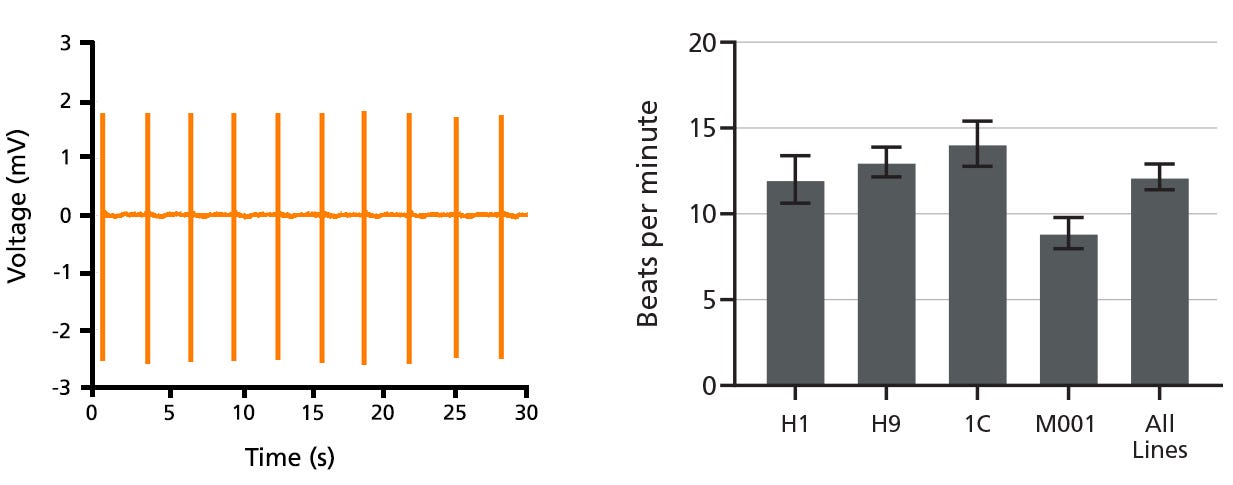
Figure 5. Post-Expanded hPSC-Derived Cardiomyocytes Exhibit Typical Cardiac Electrophysiology and a Stable Beat Profile
Microelectrode Array (MEA) recordings of post-expanded hPSC-derived cardiomyocytes (using STEMdiff™ Cardiomyocyte Expansion Kit) exhibit a stable beat rate across 4 hPSC lines. The post-expanded hPSC-derived cardiomyocytes were replated onto MEA and maintained in STEMdiff™ Cardiomyocyte Maintenance Medium for 1 week. The average beat rate was 12 ± 1 beats per minute (n = 14, 4 hPSC lines).
Protocols and Documentation
Find supporting information and directions for use in the Product Information Sheet or explore additional protocols below.
Applications
This product is designed for use in the following research area(s) as part of the highlighted workflow stage(s). Explore these workflows to learn more about the other products we offer to support each research area.
Resources and Publications
Educational Materials (8)
Related Products
-
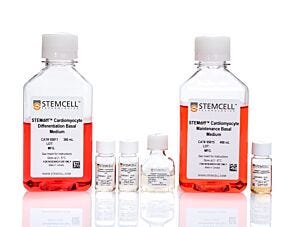 STEMdiff™ Ventricular Cardiomyocyte Differe...
STEMdiff™ Ventricular Cardiomyocyte Differe...Serum-free media for differentiation of human PSCs to ventricular cardiomyocytes and long-term maintenance of human PSC-derived cardiomyocytes
-
 STEMdiff™ Cardiomyocyte Maintenance Kit
STEMdiff™ Cardiomyocyte Maintenance KitMedium for long-term maintenance of human PSC-derived cardiomyocytes
-
 STEMdiff™ Cardiomyocyte Dissociation Kit
STEMdiff™ Cardiomyocyte Dissociation KitFor dissociation of hPSC-derived cardiomyocytes
-
 STEMdiff™ Cardiomyocyte Support Medium
STEMdiff™ Cardiomyocyte Support MediumMedium for thawing and culturing hPSC-derived cardiomyocytes
-
 STEMdiff™ Atrial Cardiomyocyte Differentiat...
STEMdiff™ Atrial Cardiomyocyte Differentiat...Serum-free culture medium kit for differentiation of human PSCs to atrial cardiomyocytes
Item added to your cart

STEMdiff™ Cardiomyocyte Expansion Kit
PRODUCTS ARE FOR RESEARCH USE ONLY AND NOT INTENDED FOR HUMAN OR ANIMAL DIAGNOSTIC OR THERAPEUTIC USES UNLESS OTHERWISE STATED. FOR ADDITIONAL INFORMATION ON QUALITY AT STEMCELL, REFER TO WWW.STEMCELL.COM/COMPLIANCE.
